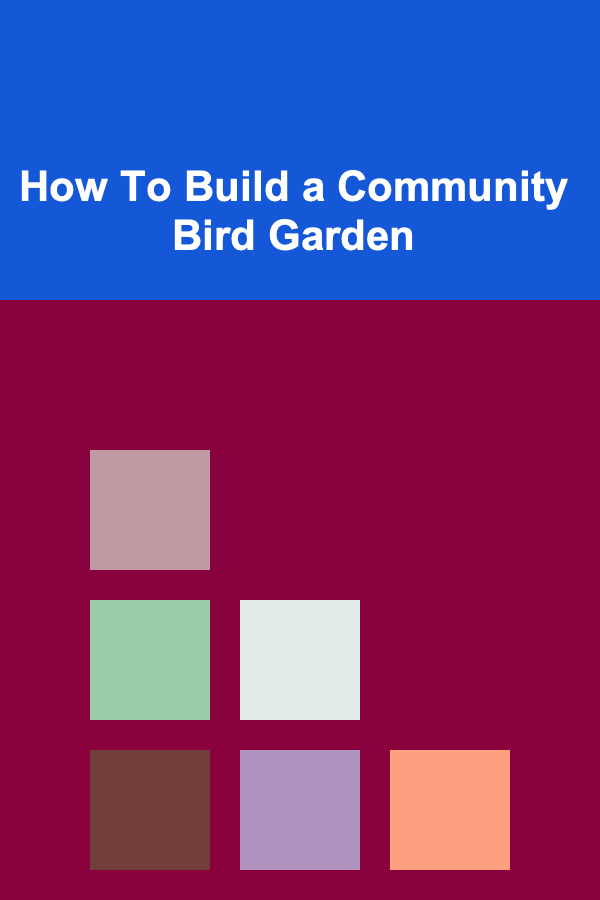
How To Build a Community Bird Garden
ebook include PDF & Audio bundle (Micro Guide)
$12.99$9.99
Limited Time Offer! Order within the next:

Building a community bird garden is not only a rewarding project that benefits local wildlife, but it also offers the chance to create a space where neighbors can come together and enjoy nature. A bird garden can attract a variety of species, foster biodiversity, and provide educational opportunities for children and adults alike. Whether you are planning to create a bird-friendly space in your backyard, a shared garden in your neighborhood, or a public community garden, there are several essential steps and considerations to take into account.
This guide will walk you through the process of building a community bird garden, offering insights into planning, plant selection, habitat design, and community engagement. By the end of this article, you will have a comprehensive understanding of how to create a sustainable and welcoming space for both birds and people.
Why Build a Community Bird Garden?
Before diving into the specifics of garden design, it's important to understand why bird gardens are so beneficial. Bird gardens contribute to local ecosystems in a variety of ways:
1.1 Promoting Biodiversity
Birds are an integral part of any ecosystem. They help with seed dispersal, insect control, and pollination. A bird garden can support various species of birds, including migratory birds, songbirds, and ground feeders. By providing a variety of habitats, you can attract a wide range of species, which in turn promotes biodiversity and helps maintain a balanced ecosystem.
1.2 Enhancing Local Beauty
A bird garden can transform an ordinary space into an extraordinary one. The presence of colorful flowers, shrubs, trees, and water features can create an aesthetically pleasing environment. In addition, the sight and sound of birds can enhance the natural beauty of the area, creating a peaceful, tranquil space where people can relax and enjoy nature.
1.3 Fostering Community Engagement
Building a community bird garden is an excellent way to bring people together. Gardening is a collaborative activity that encourages teamwork and a sense of shared responsibility. It can be an opportunity for neighbors to connect, share knowledge, and contribute to something meaningful. Additionally, birdwatching provides an engaging activity that can be enjoyed by people of all ages and backgrounds.
1.4 Providing Educational Opportunities
A bird garden can serve as an outdoor classroom. It provides opportunities for both children and adults to learn about birds, their habitats, and the environment. Schools, community organizations, and local wildlife groups can use the garden as a resource to teach about conservation and sustainability.
Planning Your Community Bird Garden
Building a successful bird garden requires careful planning. The first step is to assess your site and understand the needs of the birds you wish to attract. Consider the following factors:
2.1 Site Assessment
The location of your bird garden is crucial for its success. Birds have specific needs, including food, water, shelter, and nesting sites. Before starting, evaluate your space to ensure it can accommodate these requirements. Here are some key things to consider:
- Sunlight: Most bird-friendly plants need adequate sunlight. Observe how much sun your garden area receives throughout the day.
- Wind and Weather: Choose a sheltered location for your garden. Windbreaks such as fences or trees can help provide a safe haven for birds during strong winds or storms.
- Space and Size: Ensure there is enough space for a variety of plants, water features, and birdhouses. It's important to design the garden in a way that provides both open spaces for ground feeders and sheltered areas for birds that prefer a more protected environment.
2.2 Identifying Target Bird Species
Research which birds are native to your area and would benefit from the types of plants and habitats you plan to create. Different species have different needs, so understanding the local bird population will help you plan more effectively. Some birds may prefer open spaces with grasses, while others may favor dense shrubs or tall trees.
2.3 Setting Goals for the Garden
Establish clear objectives for your bird garden. What do you want to achieve? Do you want to attract specific species? Do you hope to create a garden that can be enjoyed by people, too? Setting goals will help you stay focused during the planning process and ensure your efforts are successful. Your goals might include attracting certain bird species, providing nesting sites, or creating a space that fosters community engagement.
Choosing the Right Plants for Your Bird Garden
Plants play a key role in attracting birds to your garden. They provide food, shelter, and nesting sites, and can even act as natural barriers against predators. When choosing plants, focus on native species, as they are more likely to support the local wildlife and thrive in the existing conditions.
3.1 Native Plants
Native plants are adapted to the local climate and soil, and they provide the best food and shelter for native bird species. They support local insect populations, which in turn provide a valuable food source for birds. Native plants also help to preserve the local ecosystem by preventing the spread of invasive species.
Here are a few types of plants to consider for your bird garden:
- Trees: Trees such as oaks, maples, and pines provide shelter and nesting sites for birds. They also produce berries, nuts, and seeds that birds can feed on.
- Shrubs: Shrubs like holly, viburnum, and elderberry provide cover for smaller birds and produce fruits that attract a variety of species.
- Flowers: Wildflowers such as coneflowers, sunflowers, and asters are great for attracting insects, which birds can feed on. They also offer seeds for birds like finches and sparrows.
- Grasses and Groundcovers: Grasses like fescue and sedge provide ground cover and nesting sites for ground-feeding birds like sparrows and doves.
3.2 Layering Plant Height
To create a diverse and welcoming environment, consider layering plants of varying heights. This creates a range of habitats, from low-growing groundcovers to tall trees. This diversity ensures that different types of birds, from ground feeders to canopy dwellers, will find suitable places to forage, rest, and nest.
3.3 Providing Food Sources
In addition to plants, you can incorporate food sources such as bird feeders. These can be stocked with seeds, suet, and nectar to attract different types of birds. Be sure to choose the appropriate food for the species you want to attract. For example:
- Seeds: Sunflower seeds, millet, and thistle are popular with many types of birds, including finches, chickadees, and sparrows.
- Nectar: Hummingbirds are drawn to nectar-filled flowers or specialized feeders with sugar water.
- Suet: Woodpeckers, nuthatches, and other insect-eating birds appreciate suet, especially in the winter months.
Creating Water Features
Birds need water for drinking and bathing. Including a water feature in your garden is essential for attracting birds. It can also enhance the overall beauty and tranquility of the space.
4.1 Birdbaths
A simple birdbath can be a wonderful addition to your garden. Place it in a quiet, shaded area to reduce the risk of predators. Make sure to clean the birdbath regularly to prevent the spread of disease. You can also add pebbles or stones to the bottom to give smaller birds a place to stand while drinking or bathing.
4.2 Ponds or Streams
If you have the space and resources, a small pond or stream can attract a variety of birds. The sound of running water is especially appealing to birds and can create a peaceful ambiance in the garden. Make sure the water is shallow enough for birds to wade into safely, and provide areas of vegetation or rocks where they can perch.
Providing Shelter and Nesting Sites
In addition to food and water, birds need places to shelter and nest. Consider incorporating the following elements to provide a safe and secure environment:
5.1 Birdhouses
Birdhouses are essential for providing nesting sites for cavity-nesting birds such as chickadees, wrens, and bluebirds. When selecting birdhouses, make sure they are the appropriate size for the species you want to attract. The entrance hole size, ventilation, and drainage are all important factors to consider.
5.2 Dense Shrubs and Trees
Providing dense shrubs or evergreen trees in your garden gives birds places to hide from predators, rest, and shelter during inclement weather. These plants also offer excellent nesting opportunities.
5.3 Ground Cover
Ground cover plants like ivy or low-growing ferns can also provide shelter for ground-dwelling birds. Additionally, leaf litter or a compost pile can provide a safe, natural space for birds to forage for insects and seeds.
Engaging the Community
Creating a community bird garden is not just about providing a habitat for birds---it's about bringing people together. Here are a few ways to get the community involved:
6.1 Organize Workdays
Encourage community members to get involved by organizing regular garden workdays. These can be opportunities to plant, clean up, and maintain the space. By working together, neighbors can build a sense of ownership and pride in the garden.
6.2 Host Birdwatching Events
Birdwatching is an activity that can engage people of all ages. Host events where community members can come together to observe the birds that visit the garden. Provide bird identification guides or invite local ornithologists to lead educational walks.
6.3 Educational Workshops
Offer workshops on topics such as bird conservation, gardening for wildlife, and sustainable practices. These workshops can help community members gain a deeper understanding of the importance of bird habitats and how they can contribute to conservation efforts.
Conclusion
Building a community bird garden is a rewarding project that can provide benefits for both people and wildlife. By carefully planning the layout, selecting the right plants, providing food and water, and involving the community, you can create a space that attracts a diverse range of bird species and fosters a sense of connection among neighbors. Whether you're creating a backyard sanctuary or a public garden, a community bird garden is an investment in the health of local ecosystems and the well-being of the community. So grab your tools, gather your neighbors, and start planning your very own bird-friendly garden today!

How to Maintain a Tidy Home During Busy Weeks
Read More
How to Maximize Returns with a Money Market IRA
Read More
How to Remove Grease and Grime from Kitchen Surfaces
Read More
Finding Compatible Partners Online: A Comprehensive Guide
Read More
How to Integrate Pilates with Your Existing Workout Routine
Read More
How to Design Logos That Stand the Test of Time
Read MoreOther Products

How to Maintain a Tidy Home During Busy Weeks
Read More
How to Maximize Returns with a Money Market IRA
Read More
How to Remove Grease and Grime from Kitchen Surfaces
Read More
Finding Compatible Partners Online: A Comprehensive Guide
Read More
How to Integrate Pilates with Your Existing Workout Routine
Read More